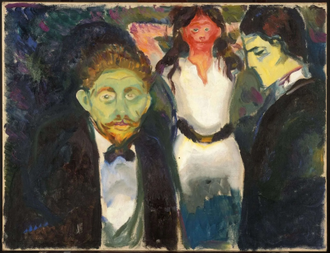Gospel in Art: Peter turned and saw the disciple whom Jesus loved

Jealousy, Painted by Edvard Munch in 1907 © The Munch Museum, Oslo
Source: Christian Art
Gospel of 7 June 2025
John 21:20-25
At that time: Peter turned and saw the disciple whom Jesus loved following them, the one who also had leaned back against him during the supper and had said, 'Lord, who is it that is going to betray you?' When Peter saw him, he said to Jesus, 'Lord, what about this man?' Jesus said to him, 'If it is my will that he remain until I come, what is that to you? You follow me!' So the saying spread abroad among the brothers and sisters that this disciple was not to die; yet Jesus did not say to him that he was not to die, but, 'If it is my will that he remain until I come, what is that to you?'
This is the disciple who is bearing witness about these things, and who has written these things, and we know that his testimony is true.
Now there are also many other things that Jesus did. Were every one of them to be written, I suppose that the world itself could not contain the books that would be written.
Reflection on the Expressionist painting
In today's Gospel reading, we witness a quiet but profound moment between Jesus and Peter, just after Jesus has foretold Peter's future martyrdom (the theme of yesterday's reading). Peter, perhaps still processing the weight of this calling, turns and sees the beloved disciple following them. He asks Jesus, "Lord, what about him?"-a question that, on the surface, may seem harmless, but hints at a deeper human instinct: the urge to compare, to measure one's path against another's, even a hint of jealousy. In response, Jesus says firmly, "If I want him to remain until I come, what is that to you?" It is a gentle yet pointed rebuke against jealousy and comparison.
Here, Jesus reminds Peter, and all of us, that each calling is unique, and that our discipleship must not be clouded by envy or rivalry. The temptation to look over our shoulder at someone else's path, wondering why their burdens seem lighter or their blessings greater, is a deeply human one. But Jesus calls us to keep our gaze fixed on Him alone. He does not ask us to run someone else's race, but to follow Him in faithfulness, wherever that may lead. In this brief exchange, Jesus teaches that jealousy distracts us from our vocation and distorts our trust in God's plan.
Edvard Munch's painting Jealousy explores the darker, more painful side of love: where affection becomes entangled with envy and resentment. The composition centres around a woman with blushing red cheeks, caught between two men. One man looks away in sorrow or regret, while the other stares out at the viewer with an intense, almost haunting expression of jealousy. His face is painted in greenish tones, immediately evoking the phrase "green with envy"-a saying that dates back to Shakespeare, who famously referred to jealousy as the "green-eyed monster" in Othello. Munch deliberately uses the colour green here to symbolise emotional toxicity, inner turmoil, and the corrosive power of envy.
The colour symbolism in our painting is powerful: green, associated with jealousy, is the complementary colour to red, the colour of love. Munch, a master of emotional expression, enhances the tension through messy, unsettled brushstrokes that reflect the psychological chaos and disunity between the figures. The painting doesn't depict a specific moment but rather an emotional atmosphere, one of suspicion, rivalry, and loss. In this way, Jealousy becomes not just a portrayal of a love triangle, but a visual meditation on how comparison and possessiveness can distort our relationships... even our relationship with God.
LINKS
Gospel in Art: https://christian.art/
Today's Reflection: https://christian.art/daily-gospel-reading/john-21-20-25-2025/ (with audio)


















